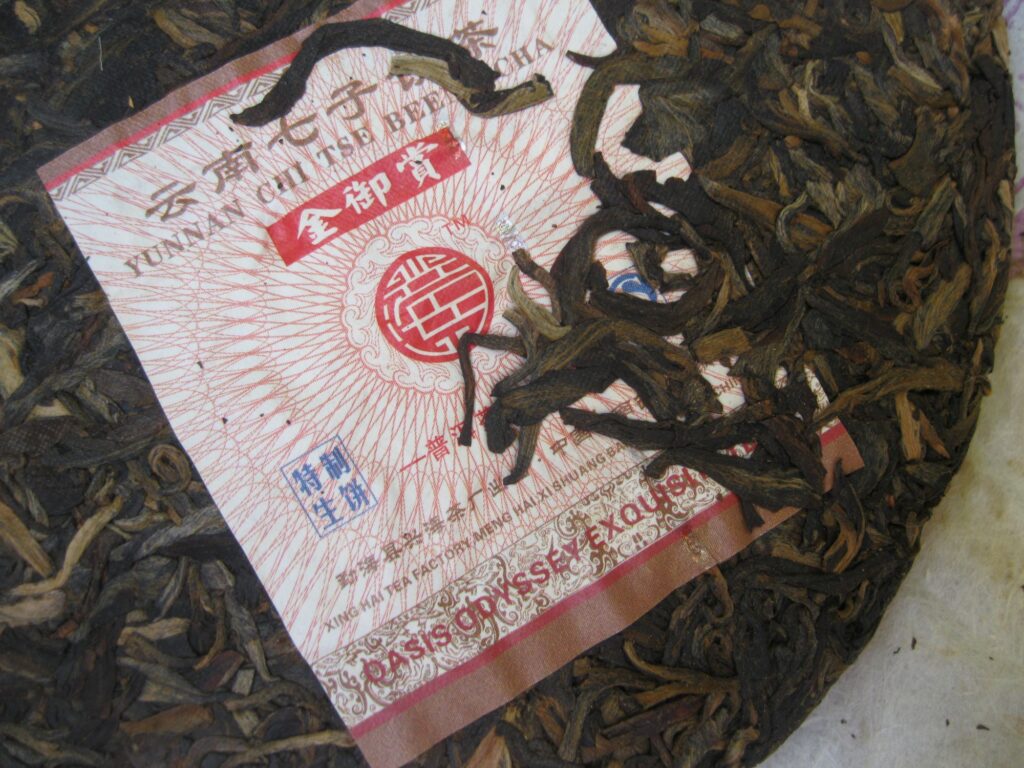March ’24 Puerh Musings

March ’24 Puerh Musings must be prefaced by commentary upon the ventures of some individual(s) who thought it necessary to scrawl my personal FB postings to otherwise disaffect those who might be affected by my views on matters entirely unrelated to tea. I’d like to dedicate this post to them and hope whatever ventures upon which they engage beyond defamation do well. For what it’s worth, I do not retract one scintilla of what I’ve posted. At the same time, I do not care to belabour matters about which most have very little discernment, which has essentially been my life purpose. I welcome any interlocutors who are of good faith, but it should be noted that were I a conventionalisto, then that which I’ve been able to offer would be off the radar because I’d be too busy adhering to “herdism,” that which is anathema to my being. . . eh? (though I’m not Canadian)
We now resume with the third-person lens where we find the Puerh Junky moving from the kitchen of burping cabbage fermented concoctions to the front room alcove, where he crafts his “musings.” He has designs to discuss the few Zhongcha/Chinatea offerings upon which he’s been sitting as well as some Xinghai and other productions that have been sitting in the cave for a while. In particular, he feels that there have been some ripes deserving mention. He’ll start there.
Leap Week LME Ripes
Leap Week LME Ripes occurred spontaneously. For clarity’s sake, LME stands for the Laoman’e brand and not the terroir, per se, though all of their productions seem to come the three same terroir: Bulang, Nannuo, and Banzhang. All LME ripe offerings can be characterized as rich and dense, having full fermentation. There’s full mouthfeel and considerable bitter finish. This bitterness is likely their most distinguishing feature. They provide a range of entry points in terms of price. Prices for widely available productions tend to hold steady, but the Arbor King and BZ Peacock have shown movement to the upside, the latter being a rather extraordinary offering.
The week started out with the ’12 Arbor King, which proved to be its poorest performance ever. Typically, there’s a cherry note that accompanies its intensity but this time it could not be detected and it was definitely on the flat papery side. It’s not likely the storage, at the same time AK has not been temperamental. The best guess is the weather and I’ll be sure to revisit in the next month or two for latest developments. Overall, I found the visit disappointing and a later visit in the week proved no better, even after airing a bit.
I recently picked up three more ’11 Orchid Vibe. It’s a good price and I’ve enjoyed the vanilla, along with a fermentation that’s a bit lighter than the others, though by no means light. I stored it in the ripe big box. The taste is vastly different from the past with much more wood resin. It seemed quite similar to the Langhe Ripe Tuo, though they’re stored in different places. Overall quality and character are solid, but the personality differs greatly from any previous session in tasting for a number of years now. Again, must be the rainy-season effects.
By this time, the Puerh Junky had a fancy to test a LCGC ripe acquired in Nov ’23. A more exhaustive write-up on LCGC ripes will be in order some time this year ’24. The year ’23 had Puerh Junky more curious about their ripes. It proved a good change of pace, as it brought the LME ripe house style into greater relief. The greatest difference? Sweetness. The LCGC possesses a light molasses and Wheat Chex quality. The sweetness adds a layer of thickness, though it’s not sticky sweet. Since Old Geezers which sold out to a local fiend, I haven’t found such a production.
Finally, there was the ’06 Nannuo, LME. It’s in the ripe sampler set #4. This was sampled straight from storage and twice thence in the same week. Each time, totally blind, PJ’s wife made remarks whereas none of the others elicited a peep. The Nannuo, of which, I’ve picked up three more in a most recent order (yet to be received), possesses a layer of Vienna Fingers vanilla cookie. There’s a top layer of this with the LME house bitter finish. Still is not remarkably sweet.
All were brewed in my ripe pot 10-12g about 3m to start at same or upward with about four infusions. No vegetal at all. Prices for these between in the $60s-110. Samples avail in Sampler U or on respective page.
Zhongcha
Zhongcha is ChinaTea. I’m trying to get use to using that name more frequently. They’re a full-range outfit but most of that which Puerh Junky offers is in the “peoples” and midrange priced offerings. There have been a few individuals who’ve examined the leaves and made critical remarks, then showing me Chenshenghao’s yedi. I’ve not endevoured to portray my ZC’s on par with CSH’s, but when I look at such monochromatic leaves, I immediately suspect blow drying. No bueno. In any event, Zhongcha has presented itself as a volume seller of casual drinkers that “the people” can afford. Until ’14 they adhered to strict processing methods that didn’t pander to quick-sweet tastes. Furthermore, they’re iconic and worth visiting for a sense of classic puerh history. Since ’07 the Zhongcha brand has been synonymous with Kunming TF, though there’s an out layer or two. Initial forays into Zhongcha were with the ’07 offerings, with a few offered as late as ’16. In ’23, I ventured into a few ’06 and ’08 with generally positive findings but much different from the ’07s that had served as a centerpiece of acquisition from between ’14-’20. Astringency is much greater in the ’06 and ’08s.
During the leap week I visited two relatively recent productions, the ’12 Mangosteen and the ’13 Bulang Shengtai. I had to sit the Mangosteen out for two weeks after first test. There’s a very high-pitched camphor note that may only be detected by mouth cooling for newbies. There a middle note of aged fruit, plum possibly, with a zing of erstwhile mangosteen, but a wicked astringency that is altogether not in comportment with the house style as I know it. I’m still not offering, though I’ve had on hand since ’14, only offering to those confident about their storage. Having tracked essentially since inception, two more years seems the minimum. It has maximo classical processing and I’m optimistic given it innate character. First batch, late March/early April. It’s bona fide and taking it time. At least three on hand.
The ’13 Bulang Shengtai has been more fudged in processing if the Mangosteen serves as any comparison The sugars have already come in, an overall fruity character, having an element of bitterness. Zen front, fruit second, not unfriendly. Easy. Everyday drinker. A good candidate for one unfamiliar with 10yr plus productions that have been only moderately fired. The wrapper is iconic, but if I’m resorting to wrapper I cannot be all that taken. It’s very possible that it’s just early. The 10yr spot is just for starters, nothing negative, seasonal factors included. Fine. Much better than two years ago. Again, the sugars are present but Zen needs some differentiation from bland. A good conservative starter for testing your brewing method. I’m expecting more with the the weather changes, say late Aug. Hit me up. I won’t raise price in next two years. I plan to post on a Zhongcha page at the latest by May ’24.
Xinghai
Xinghai grabbing continued afoot in ’23. Now is a time for proper testing the first stage. We’ll visit the ’07 Oasis Odyssey, ’07 Paolo Santo, and the ”06 Treasured. I also tried the ’06 Bulang GS, which is prolly issued under ’07, but I’m willing to give it some time. Let’s start with the Oasis Odyssey.
Oasis Odyssey seems to have been acquired in May ’23, offered in Nov of the same year. Over time, it has traversed from oily purple to the typical astringent XH personality with good salivation effect as opposed to drying. Mostly in the Zen Class. Compression is massive. The purple has diminished in expression. Balanced sweetness. We’ll have to observe how it evolves in relation to the changes of the seasons. I’m looking for more oil and purple as last year.
The ’07 Paolo Santo tuo has me rather excited. It’s a second batch production that has lemon and wood attributes. I can easily see how the first round would be much more expensive. No smoke, high limonene wood expression, not too sweet. smattering of bitter. It’s not available presently, as I only acquired in Nov ’23 but around May ’24 will be. Bright wood bitter, lemonime, complex, nice. It’s very promising. Not sweet but quintessentially Xinghai. Qi is overall warming and settling.
Finally, there is the Treasured, acquired in Jun ’23. It has yet to be listed, but one of the projects for the Xinghai Raw page two. Treasured is the second batch. It’s in the Tobacco Class, possibly approaching tequila. Not atomically pressed, with a nice balance of smoked wood, wood resin, sweetness, and astringency. Probably the most notable element regards storage. Most productions require the proper treatment that these LA environs provide. Even then, it takes several months to bring them into a form that make them presentable. It’s needed every bit of the nine months to come to form. It’ll appear on the XH second page for certain.
Wrap up
March ’24 Puerh Musings have covered a range of raws and ripes. The ripes were confined to Puerh Junky’s LME offerings, while raws involved Zhongcha and Xinghai productions. LME ripes stand out for their bitter finish. ZC’s ’12 Mangosteen is showing promise, but the astringency is a bit of a hair raiser presently, so it’ll sit at least till after the summer. The ’13 Bulang Shengtai will be posted soon on a page with a few other others. The Xinghai visits covered two productions that will also be listed soon. If all goes well, at the latest mid-May. Each has a distinctive profile and all being second batches are very reasonably priced: Oasis Odyssey is Zen with balanced sweetness; Paolo Santo is as the name suggests with remarkable qi; Treasured offers wood complexity of Tobacco Class. Paolo Santo is also Tobacco Class, but possesses a vastly different quality from Treasured, more closely resembling their Green Peacock.
